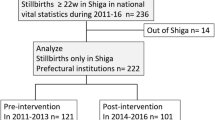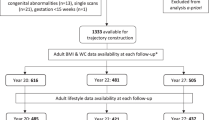Abstract
Our objective was to investigate the longitudinal development of incidence parameters of fetal body movements to define normal reference ranges, to relate them to episodes of fetal heart rate patterns A and B, and to determine the intrafetal consistency for these parameters. Twenty-nine fetuses were studied longitudinally from 24 wk of gestation. Fetal body movements and heart rate were recorded at fortnightly intervals between 24 and 36 wk of gestation and weekly from 36 wk of gestation. Data were analyzed using multilevel analysis. Reference ranges were constructed for the percentage of observation time that movements were present, the number of movement bursts per hour, the mean burst duration, and the median onset–onset interval. The median percentage incidence of fetal body movements decreased from 17% at 24 wk to about 7% near term. The developmental course was the same during active episodes. Body movements also decreased during episodes of relative quiescence, in the course of pregnancy. Intrafetal variance was on average 40–80% of the total range of the four movement parameters. Normal reference ranges were developed for incidence parameters of fetal body movements from 24 wk of gestation onward. The overall decline in the incidence of movements during pregnancy appeared to be a developmental phenomenon and not due to progressively increasing episodes of fetal quiescence. Individual fetuses showed a degree of consistency in the percentage incidence of body movements, but intra- and interfetal variances were generally high, resulting in wide ranges.
Similar content being viewed by others
Log in or create a free account to read this content
Gain free access to this article, as well as selected content from this journal and more on nature.com
or
Abbreviations
- FHR:
-
fetal heart rate
- FHRP:
-
fetal heart rate pattern
References
Lamb B, Lang R 1992 Aetiology of cerebral palsy. Br J Obstet Gynaecol 99: 176–178
Manning FA, Platt LD, Sipos L 1979 Fetal movements in human pregnancies in the third trimester. Obstet Gynecol 54: 699–702
Visser GHA, Mulder EJH, Prechtl HFR 1992 Studies on developmental neurology in the human fetus. Dev Pharmacol Ther 18: 175–183
Prechtl HFR 1988 Developmental neurology of the fetus. Baillieres Clin Obstet Gynaecol 2: 21–36
Prechtl HFR, Einspieler C 1997 Is neurological assessment of the fetus possible?. Eur J Obstet Gynecol Repr Biol 75: 81–84
Krasnegor NA, Fifer W, Maulik D, McNellis D, Romero R, Smotherman W 1998 Fetal behavioural development: a transdisciplinary perspective for assessing fetal well-being predicting outcome. Prenat Neonat Med 3: 185–190
de Vries JIP, Visser GHA, Prechtl HFR 1988 The emergence of fetal behaviour. III. Individual differences consistencies. Early Hum Dev 16: 85–103
Patrick J, Campbell K, Carmichael L, Natale R, Richardson B 1982 Patterns of gross fetal body movements over 24-hour observation intervals during the last 10 weeks of pregnancy. Am J Obstet Gynecol 142: 363–371
Patrick J, Campbell K, Carmichael L, Natale R, Richarson B 1980 Patterns of human fetal breathing during the last 10 weeks of pregnancy. Obstet Gynecol 56: 24–30
Natale R, Nasello Paterson C, Turliuk R 1985 Longitudinal measurements of fetal breathing, body movements, heart rate, heart rate accelerations decelerations at 24 to 32 weeks of gestation. Am J Obstet Gynecol 151: 256–263
Roberts AB, Griffin D, Mooney R, Cooper DJ, Campbell S 1980 Fetal activity in 100 normal third trimester pregnancies. Br J Obstet Gynaecol 87: 480–484
Nasello Paterson C, Natale R, Connors G 1988 Ultrasonic evaluation of fetal body movements over twenty-four hours in the human fetus at twenty-four to twenty-eight weeks' gestation. Am J Obstet Gynecol 158: 312–316
Bekedam DJ, Visser GHA, Mulder EJH, Poelmann Weesjes G 1987 Heart rate variation movement incidence in growth-retarded fetuses: the significance of antenatal late heart rate decelerations. Am J Obstet Gynecol 157: 126–133
Roodenburg PJ, Wladimiroff JW, van Es A, Prechtl HFR 1991 Classification quantitative aspects of fetal movements during the second half of normal pregnancy. Early Hum Dev 25: 19–35
Visser GHA, Goodman JDS, Levine DH, Dawes GS 1982 Diurnal other cyclic variations in human fetal heart rate near term. Am J Obstet Gynecol 142: 535–544
Devoe LD, Youssef AA, Castillo RA, Croom CS 1994 Fetal biophysical activities in third-trimester pregnancies complicated by diabetes mellitus. Am J Obstet Gynecol 171: 298–303
ten Hof J, Nijhuis IJ, Nijhuis JG, Narayan H, Taylor DJ, Visser GH, Mulder EJ 1999 Quantitative analysis of fetal general movements: methodological considerations. Early Hum Dev 56: 57–73
Ribbert LSM 1993 Assessment of fetal well-being in growth retardation. Ph.D. thesis, University of Groningen, Groningen, The Netherlands, pp 29–34
Nijhuis IJM, ten Hof J, Mulder EJH, Nijhuis JG, Narayan H, Taylor DJ, Westers P, Visser GHA 1998 Numerical fetal heart rate analysis: nomograms, minimal duration of recording intrafetal consistency. Prenat Neonat Med 3: 314–322
Nijhuis IJM, ten Hof J, Mulder EJH, Nijhuis JG, Narayan H, Taylor DJ, Visser GHA 1998 Fetal heart rate (FHR) parameters during FHR patterns A B: a longitudinal study from 24 weeks' gestation. Prenat Neonat Med 3: 383–393
Gardosi J, Mongelli M, Wilcox M, Chang A, Sahota D, Francis A 1997 Gestation related optimal weight (GROW) program. Software version 2. Nottingham, U.K., PRAM, University of Nottingham.
Wright KW 1995 Pediatric ophthalmology and strabismus. Mosby, St. Louis, MO, pp 310–312
Visser GHA, de Vries JIP, Mulder EJH, Ververs IA, van Geijn HP 1993 Effects of frequent ultrasound during pregnancy [letter; comment]. Lancet 342: 1359–1360
Stark CR, Orleans M, Haverkamp AD, Murphy J 1984 Short- long-term risks after exposure to diagnostic ultrasound in utero. Obstet Gynecol 63: 194–200
Reece EA, Assimakopoulos E, Zheng X-Z, Hagay Z, Hobbins JC 1990 The safety of obstetric ultrasonography: concern for the fetus. Obstet Gynecol 76: 139–146
Kossoff G 1997 Editorial: Contentious issues in safety of diagnostic ultrasound. Ultrasound Obstet Gynecol 10: 151–155
Anonymous 1976 Biological effects of ultrasonic energy on living mammals. Ultrasound Med Biol 2: 351
Anonymous 1983 Safety statements. J Ultrasound Med 2( suppl): 1–49
Anonymous 1988 Bioeffects consideration for the safety of diagnostic ultrasound. J Ultrasound Med 7( suppl): 53–56
ECURS, Safety ECfUR 1995 EFSUMB Guidelines for the safe use of Doppler ultrasound for clinical applications. Eur J Ultrasound 2: 167–168
de Vries JIP, Visser GHA, Prechtl HFR 1982 The emergence of fetal behaviour. I. Qualitative aspects. Early Hum Dev 7: 301–322
Cohen J 1968 Weighted kappa: nominal scale agreement with provision for scaled disagreement or partial credit. Psychol Bull 70: 213
Braakman R, Avezaat CJJ, Maas AIR, Roel M, Schouten HJA 1977 Interobserver intraobserver variation in the assessment of antepartum cardiotocograms. J Obstet Gynecol 144: 701–705
Prechtl HFR 1986 Prenatal motor development. In: Wade MG, Whiting HTA (eds) Motor Development in Children: Aspects of Coordination and Control. Nijhoff, Dordrecht, The Netherlads, pp 53–64
Goldstein H 1995 Multilevel Statistical Models, 2nd Ed. Kendall's Library of Statistics 3. University of London, London
Nijhuis JG, Prechtl HFR, Martin CB, Bots RSGM 1982 Are there behavioural states in the human fetus?. Early Hum Dev 6: 177–195
Pillai M, James DK, Parker M 1992 The development of ultradian rhythms in the human fetus. Am J Obstet Gynecol 167: 172–177
Visser GHA, Poelmann Weesjes G, Cohen TMN, Bekedam DJ 1987 Fetal behavior at 30 to 32 weeks of gestation. Pediatr Res 22: 655–658
Nijhuis JG, van de Pas M 1992 Behavioral states their ontogeny: human studies. Semin Perinatol 16: 206–210
Nijhuis IJ, ten Hof J, Nijhuis JG, Mulder EJ, Narayan H, Taylor DJ, Visser GH 1999 Temporal organization of fetal behavior from 24 weeks' gestation onwards in normal complicated pregnancies. Dev Psychobiol 34: 257–268
Visser GHA, Dawes GS, Redman CW 1981 Numerical analysis of the normal human antenatal fetal heart rate. Br J Obstet Gynaecol 88: 792–802
Drogtrop AP, Ubels R, Nijhuis JG 1990 The association between fetal body movements, eye movements heart rate patterns in pregnancies between 25 30 weeks of gestation. Early Hum Dev 23: 67–73
Mulder EJH, Visser GHA, Bekedam DJ, Prechtl HFR 1987 Emergence of behavioural states in fetuses of type-1-diabetic women. Early Hum Dev 15: 231–251
Dierker LJ, Pillay S, Sorokin Y, Rosen MG 1982 The change in fetal activity periods in diabetic nondiabetic pregnancies. Am J Obstet Gynecol 143: 181–185
Pillai M, James D 1990 Development of human fetal behavior: a review. Fetal Diagn Ther 5: 15–32
Arduini D, Rizzo G, Giorlandino C, Valensise H, Dell'Acqua S, Romanini C 1986 The development of fetal behavioural states: a longitudinal study. Prenat Diagn 6: 117–124
Dreyfus-Brisac C 1970 Ontogenesis of sleep in human prematures after 32 weeks of conceptional age. Dev Psychobiol 3: 91–121
Prechtl HFR, Fargel JW, Weinmann HM, Bakker HH 1979 Postures, motility respiration of low-risk pre-term infants. Dev Med Child Neurol 21: 3–27
Darrah J, Redfern L, Maguire TO, Beaulne AP, Watt J 1998 Intra-individual stability of gross motor development in full-tem infants. Early Hum Dev 52: 169–179
Smith JH, Dawes GS, Redman CWG 1987 Low human fetal heart rate variation in normal pregnancy. Br J Obstet Gynaecol 94: 656–664
Groome LJ, Bentz LS, Holland SB, Swiber MJ, Singh KP, Trimm RF 1995 Individual consistency in behavioral state profiles in human fetuses between 38 40 weeks gestation. J Matern Fetal Med 4: 247–251
Roberts AB, Little D, Cooper D, Campbell S 1979 Normal patterns of fetal activity in the third trimester. Br J Obstet Gynaecol 86: 4–9
de Vries JIP, Visser GHA, Mulder EJH, Prechtl HFR 1987 Diurnal other variations in fetal movement heart rate patterns at 20–22 weeks. Early Hum Dev 15: 333–348
Author information
Authors and Affiliations
Corresponding author
Additional information
Supported by a grant from the Commission of the European Communities (Contract No. CHRX-CT 94-0613).
Rights and permissions
About this article
Cite this article
Ten Hof, J., Nijhuis, I., Mulder, E. et al. Longitudinal Study of Fetal Body Movements: Nomograms, Intrafetal Consistency, and Relationship with Episodes of Heart Rate Patterns A and B. Pediatr Res 52, 568–575 (2002). https://doi.org/10.1203/00006450-200210000-00017
Received:
Accepted:
Issue date:
DOI: https://doi.org/10.1203/00006450-200210000-00017
This article is cited by
-
Reference values for a fetal movement acceleration measurement recorder to count fetal movements
Pediatric Research (2018)
-
Fetal heart rate and motor activity associations with maternal organochlorine levels: results of an exploratory study
Journal of Exposure Science & Environmental Epidemiology (2014)
-
Selective Serotonin Reuptake Inhibitors Affect Neurobehavioral Development in the Human Fetus
Neuropsychopharmacology (2011)



